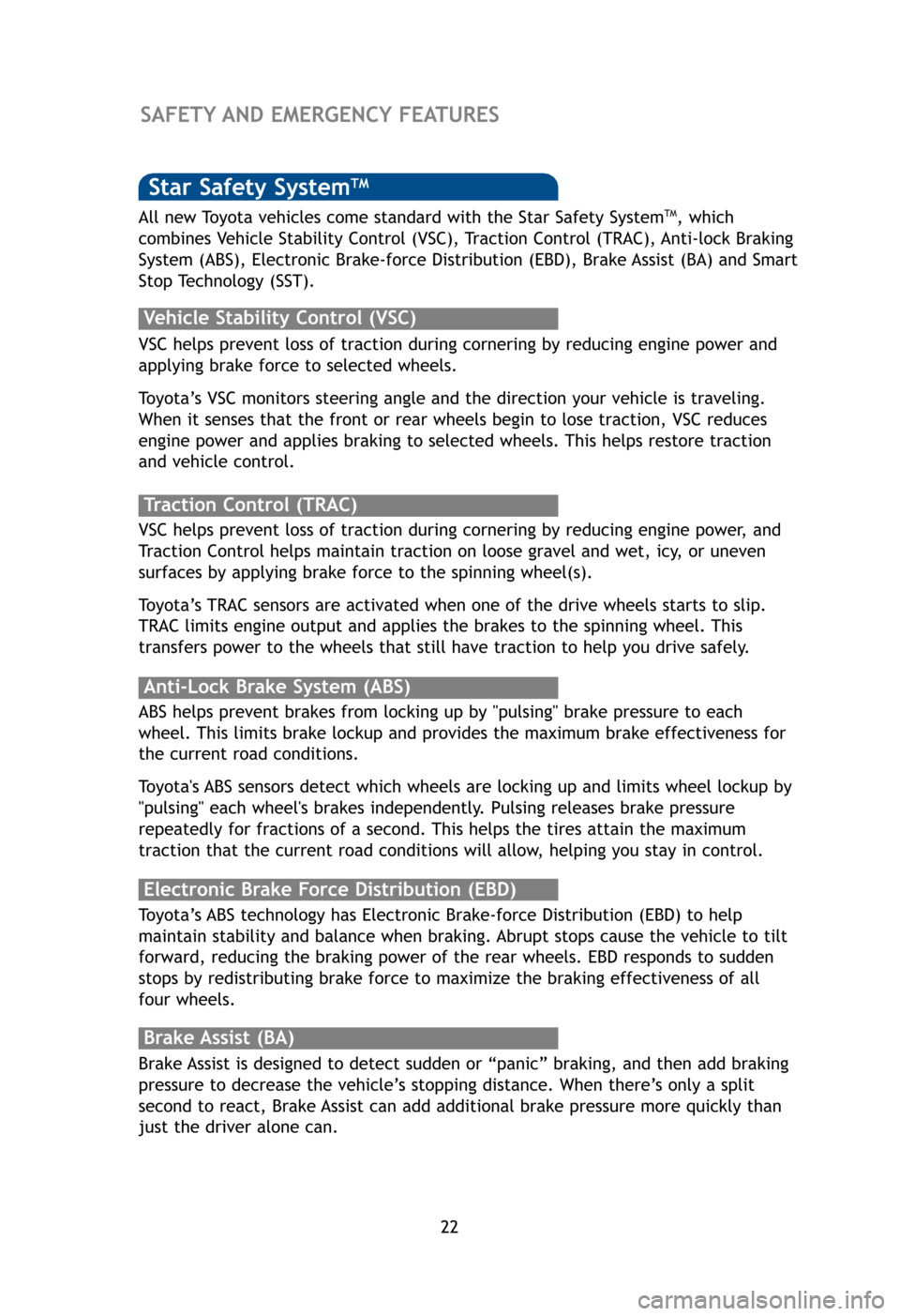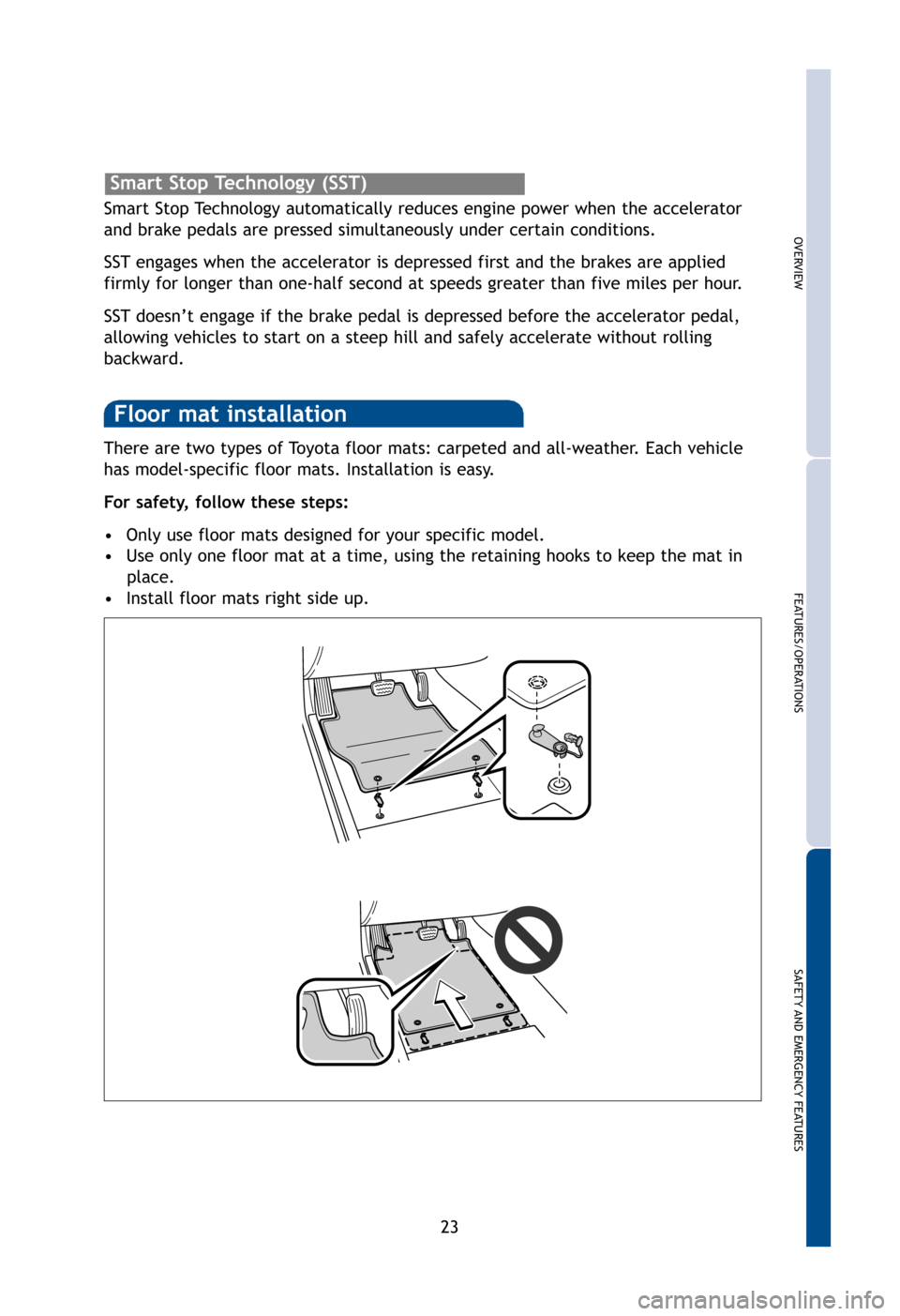stop start TOYOTA MATRIX 2012 E140 / 2.G Quick Reference Guide
[x] Cancel search | Manufacturer: TOYOTA, Model Year: 2012, Model line: MATRIX, Model: TOYOTA MATRIX 2012 E140 / 2.GPages: 28, PDF Size: 2.03 MB
Page 24 of 28

22
Star Safety SystemTM
VSC helps prevent loss of traction during cornering by reducing engine powe\
r and
applying brake force to selected wheels.
Toyota’s VSC monitors steering angle and the direction your vehicle is traveling\
.
When it senses that the front or rear wheels begin to lose traction, VSC red\
uces
engine power and applies braking to selected wheels. This helps restore traction
and vehicle control.
Vehicle Stability Control (VSC)
Anti-Lock Brake System (ABS)
Brake Assist (BA)
ABS helps prevent brakes from locking up by "pulsing" brake pressure to eac\
h
wheel. This limits brake lockup and provides the maximum brake effectiveness for
the current road conditions.
Toyota's ABS sensors detect which wheels are locking up and limits wheel lockup by
"pulsing" each wheel's brakes independently. Pulsing releases brake pressure
repeatedly for fractions of a second. This helps the tires attain the maximum
traction that the current road conditions will allow, helping you stay in control.
Brake Assist is designed to detect sudden or “panic” braking, and then add bra\
king
pressure to decrease the vehicle’s stopping distance. When there’s only a split
second to react, Brake Assist can add additional brake pressure more quickly than
just the driver alone can. VSC helps prevent loss of traction during cornering by reducing engine powe\
r, and
Traction Control helps maintain traction on loose gravel and wet, icy, or uneven
surfaces by applying brake force to the spinning wheel(s).
Toyota’s TRAC sensors are activated when one of the drive wheels starts to slip.
TRAC limits engine output and applies the brakes to the spinning wheel. This
transfers power to the wheels that still have traction to help you drive safely.
Traction Control (TRAC)
Electronic Brake Force Distribution (EBD)
Toyota’s ABS technology has Electronic Brake-force Distribution (EBD) to help
maintain stability and balance when braking. Abrupt stops cause the vehicle to tilt
forward, reducing the braking power of the rear wheels. EBD responds to sudden
stops by redistributing brake force to maximize the braking effectiveness of \
all
four wheels.
Ther
has m
For s
• O
•
Uspl
•In
Flo
SAFETY AND EMERGENCY FEATURES
All new Toyota vehicles come standard with the Star Safety SystemTM, which
combines Vehicle Stability Control (VSC), Traction Control (TRAC), Anti-lock Braking
System (ABS), Electronic Brake-force Distribution (EBD), Brake Assist (BA) and Smart
Stop Technology (SST).Smar
and
SST
e
firml
SSTd
allow
back
Sma
125432_resize Matrix-QRG.qxd 11/23/11 9:32 PM Page 22
Page 25 of 28

OVERVIEW
FEATURES/OPERATIONS
SAFETY AND EMERGENCYFEATURES
23
nd
.s
on
for
p by
.
king
han
and
n
.
tilt
en
There are two types of Toyota floor mats: carpeted and all-weather. Each vehicle
has model-specific floor mats. Installation is easy.
For safety, follow these steps:
• Only use floor mats designed for your specific model.
• Use only one floor mat at a time, using the retaining hooks to keep the mat\
in place.
• Install floor mats right side up.
Floor mat installation
king
mart
Smart Stop Technology automatically reduces engine power when the accelerator
and brake pedals are pressed simultaneously under certain conditions.
SST engages when the accelerator is depressed first and the brakes are applied
firmly for longer than one-half second at speeds greater than five miles per h\
our.
SST doesn’t engage if the brake pedal is depressed before the accelerator pedal,
allowing vehicles to start on a steep hill and safely accelerate without rolling\
backward.
Smart Stop Technology (SST)
125432_resize Matrix-QRG.qxd 11/23/11 9:32 PM Page 23